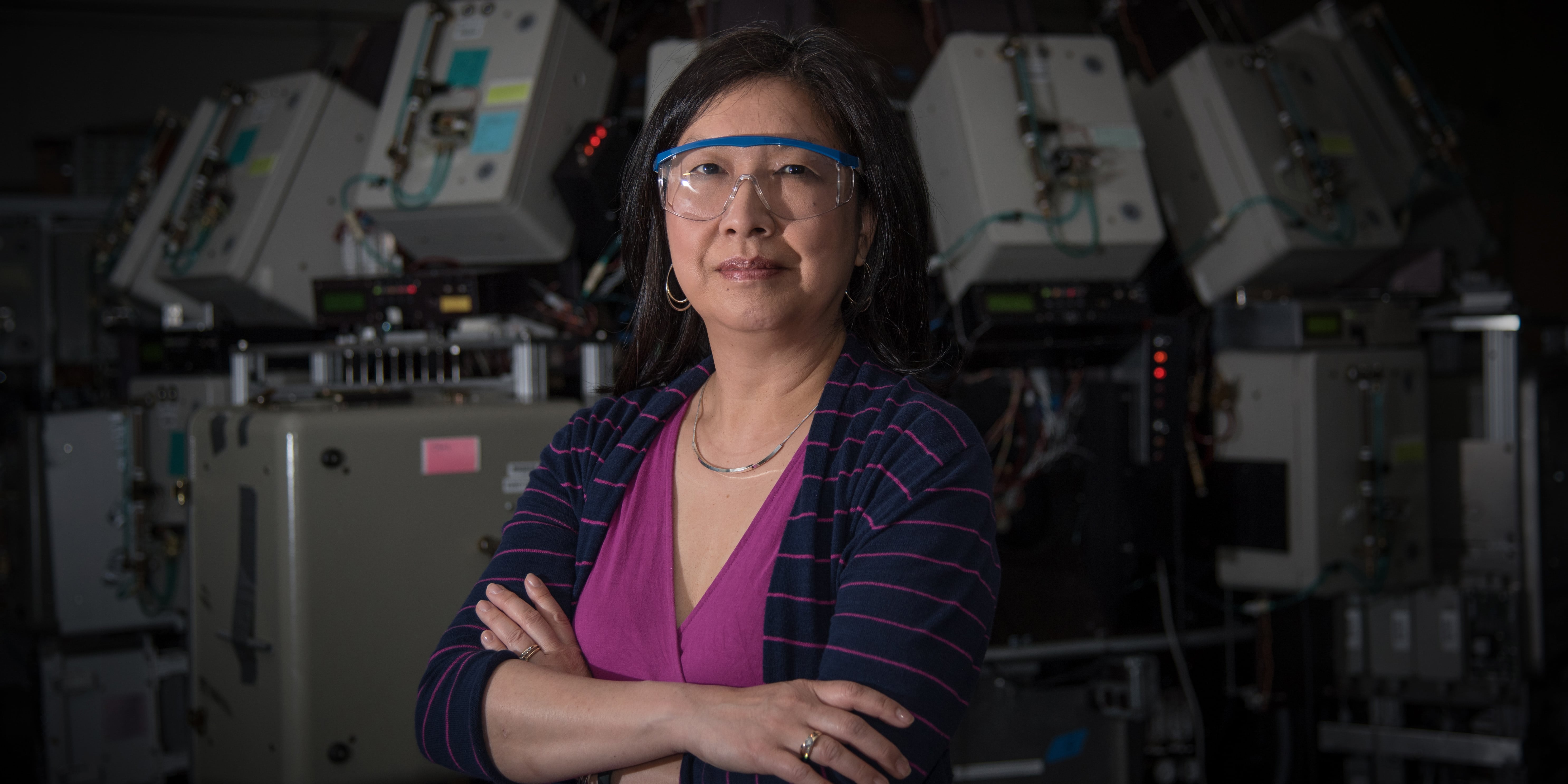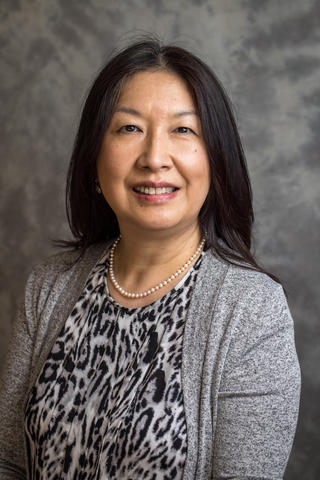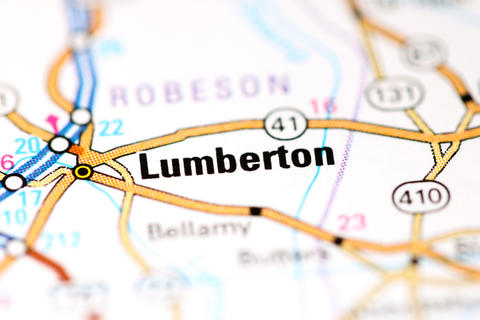Taking Measure
Just a Standard Blog
Building in a Changing Climate: A Q&A With NIST’s Joannie Chin

The vast majority of buildings we live, work and relax in have, in one way or another, caused greenhouse gases to enter our atmosphere, contributing to increasingly extreme weather that many buildings were not designed to withstand. But according to Joannie Chin, director of NIST’s Engineering Laboratory, a better understanding of the intensifying threats, building science and human behavior could help us mitigate and shield ourselves from some of the effects of climate change.
NIST public affairs specialist Jonathan Griffin spoke with Joannie for insight into some important measures NIST is taking to tackle issues around climate change.
What role does NIST play in the realm of buildings and disasters? How does it differ from the role of other agencies?
NIST’s experts are the best in the world at conducting measurement science research, and we apply that unique expertise toward understanding how to design resilient and sustainable structures and communities. We perform real-world experiments and simulations in the lab but also conduct post-disaster investigations when we suspect that specific events could teach broadly applicable lessons.
We bring the new knowledge we collect to the table when different organizations are developing model building codes and standards. These are best practices for building design and construction that can be adopted into law by state and local jurisdictions. Apart from codes, we also directly provide decision tools and resources to community leaders and individual building owners.
While we’re proficient in the world of measurement, we do often need to work with experts outside of NIST. The National Oceanic and Atmospheric Administration (NOAA) is a close partner and provides us with climate data that we incorporate into the codes and standards efforts for building energy usage. We also work with the Federal Emergency Management Agency (FEMA), which focuses on disaster response and recovery more directly, and the Environmental Protection Agency (EPA), which develops and enforces environmental regulations. The U.S. Fire Administration, the Forest Service, the National Science Foundation, the U.S. Army Corps of Engineers and many other organizations are important partners as well.
NIST’s Engineering Lab has examined the intersection of buildings, infrastructure and disasters for more than 40 years now. How has climate change influenced this work in recent years?
Back in the day, we didn't think about climate the way we do now. It was just the weather. Hurricanes and tornadoes were things that were normal. But now, in the last decade or two, we've come to understand and have reached a consensus on the role of climate change. We're seeing an increasing trend in natural hazards. For example, major wildfires used to be very rare events. Now you can basically count on them every year. Hurricanes, including stronger ones, are forming more often as well.
The Engineering Lab has been assessing extreme weather events for years, but we are doing so now more frequently than ever before. We’ve also recognized the need to be more forward looking in our research, because climate change isn't just a temporary aberration. I believe it’s going to be an existential problem for civilization moving forward. And that means, when you're trying to figure out what standards that your buildings need to meet, you have to predict what the environment around that building or community is going to be like 50-100 years from now. Traditionally, we have relied on historical data to design for future climate events, but because of climate change, that information may not always be relevant.
What are some specific research questions that need to be answered to help communities better respond to climate change?

Buildings are responsible for 40% of all U.S. energy use and around 50% of greenhouse gas emissions if you consider both the operations of buildings — electricity, heating and cooling — and the carbon that is embodied in the materials or generated by the construction process.
One of the major questions is, how do we improve the energy efficiency and decrease the footprint of buildings while, at the same time, maintaining occupant comfort and safety? We could just keep our thermostats low in the winter or not use air conditioning in the summer. That will reduce the impact on the environment, but obviously that’s not going to work very well for our comfort and health.
The NIST Engineering Lab has been researching, for quite a long time, how to design more efficient HVAC systems as well as ways to properly commission these systems and better detect faults and other issues in their operations. It's really amazing how much energy you can save by just doing a proper installation and commissioning of HVAC systems. And if we can detect faults and inefficiencies without having to look for them manually, and if the system can correct those, we can save a lot of energy. Another question we’re trying to answer is how artificial intelligence can automatically optimize building operations like these.
We also have been working on new refrigerants for HVAC systems that will have less impact on the environment. Most refrigerants we’ve been using, which can escape from leaky equipment, have the potential to warm our atmosphere thousands of times more than carbon dioxide does. And HVAC systems are not always amenable to new refrigerants, so there’s a significant amount of research we’re doing to figure out how to incorporate new refrigerants or design new systems.
We are also working with NIST colleagues to better characterize and hence maximize the performance of photovoltaic cells, as well as optimize the integration of PV and other distributed energy resources into the grid in order to reduce our reliance on coal and gas-fired power plants.
Those are some of the avenues by which we’re hoping to lower greenhouse gas emissions and maybe dampen the intensity and frequency of natural disasters. That said, we are also working to develop technical guidance for extreme weather events that are happening now and in the future.
For wildfires burning near communities in the wildland-urban interface (WUI), an important question we want to decipher is, how far should we separate things like residences, sheds, fences, vegetation and other fire hazards to mitigate fire spread in WUI zones? And what types of building materials are most fire resistant?
Our National Windstorm Impact Reduction Program is always seeking a better scientific understanding of how hurricanes, tornadoes and other storm events affect structures, and then our researchers help building codes and standards organizations incorporate the latest science. Understanding the climate effects on storm intensity and frequency is also part of our research portfolio.
There are many questions we’re addressing that go beyond keeping individual structures safe as well. Namely, how do we improve the way that whole communities prepare for, respond to and recover from natural hazards and other disruptive events? Our focus isn’t just about life safety anymore, it's about really getting communities back up and running. To do that we need to understand the interdependencies of both physical and social functions of a community — things like schools, businesses and public works — and how consequences can ripple throughout all of them.
Socioeconomically disadvantaged populations are often affected by natural disasters and the effects of climate change disproportionately. How is the Engineering Lab accounting for the specific needs of these groups?
One example of work we’re doing in this area is a longitudinal field study we’re conducting in Lumberton, North Carolina, in partnership with the Center for Risk-Based Community Resilience Planning at Colorado State University.

Lumberton is a racially and ethnically diverse community with higher-than-average unemployment and poverty rates. It was struck by Hurricane Matthew in 2016 and then Florence in 2018. The one-two punch of the hurricanes, which both caused the town to severely flood, really highlighted the disproportionate impact on the disadvantaged segment of the population. The project is ongoing, but it has and will likely continue to shine a light on the linkage between damage due to natural disasters and what the demographics of that population are. We're capturing information about social vulnerability related to race, ethnicity, income, education and things like that.
Another important effort is our ongoing investigation of Hurricane Maria’s impacts on Puerto Rico, a territory lacking the same support as U.S. states and that has had some real infrastructure issues. Hurricane Maria was a very powerful storm, but I believe we’re going to learn a lot about the connection between those existing issues and why they were hit so hard and took so long to recover. I can’t think of any mainland U.S. state that was hit by a hurricane and took this long to recover. Even today, they’re still really suffering. Even though some parts of the island are back and up and running, there are a lot of lingering issues.
There’s a lot of interesting information to find out about populations that are underserved compared with others, and what we learn could inform policies aimed at supporting these groups.
Are there other threats to the environment that EL’s research portfolio is addressing?
One that we’ve homed in on is air quality, and two aspects of it specifically. First, there’s wildfire smoke, which is a growing problem as wildfires become more common. We know that wildfire smoke can travel for hundreds of miles and really impact outdoor air quality in areas far from the fire, but it can infiltrate homes too. Our researchers are starting to probe the effects of wildfire smoke on indoor air in homes that are either adjacent to the fire or far removed.
The other aspect around air quality is related to infectious disease. The COVID-19 pandemic has raised questions such as, what’s an adequate ventilation rate for a specific room and a specific building to help make sure people aren’t catching viruses? Our researchers have been working on modeling tools that help answer questions about things like ventilation for a long time, but they’ve really seen a lot of interest in those tools lately. Applying them in the context of a pandemic has been a really interesting opportunity.
We are looking not only at molecules in the air but also the ones we incorporate into our manufactured products. The circular economy program is a recent effort where we are working with the Material Measurement Lab at NIST to figure out how we can manufacture products so that, at the end of their lives, their materials can be recycled and used again.
Things like recycling, reuse — these are not unfamiliar concepts to us, but actually being able to track the atoms and molecules in products throughout their lifecycle is going to take a lot of research, measurement science and standard test methods. But it’s necessary to keep all those atoms and molecules out of landfills, the water and the atmosphere and maintain them in the value cycle.
What are some major milestones EL has achieved in the climate space that could help communities today?
NIST has produced data, tools and guidance documents to help industry assess and quickly detect faulty operation in HVAC systems, so that repairs can be made to keep systems running at peak efficiency.
Following up on the success of identifying refrigerants with low global warming potential, NIST has collected data to develop databases on the fundamental properties of these refrigerants and their performance and safety in HVAC systems, respectively.
Our technical contributions and leadership in the development of ASHRAE Standard 189.1, which is called Standard for the Design of High-Performance Green Buildings, provides industry a path toward energy efficient buildings while improving the indoor environment and minimizing environmental impacts.
We’ve conducted and published several case studies of significant WUI fires, which are a treasure trove of useful insights that could guide community practices. Recently, we’ve gone a step further, taking the information our lab and other institutions have learned to develop the WUI Hazard Mitigation Methodology, a document that outlines recommended practices for wildfire protection across a community.
Another key resource we’ve devised, the Community Resilience Planning Guide, outlines a step-by-step process geared to help local leaders plan for natural hazards, long before they occur, using best practices. This process can address climate effects on communities and natural hazards. People will find the guide most valuable if they use it alongside tools the lab has developed to aid in decision making about investments for community resilience.





Floating waterfalls can have many benefits. Originally I imagined them circling the plastic patch. To draw sea creatures away from the plastic.
Utilitizing solar power for pumps. Solar panels hanging off of some recently decomissioned ships. Pontoons so the water fall will not sink.
Water falling 100 feet or more will make a mist around the Falls. Protecting the sea by cooling the ocean. A mist will develope. Helping the land by putting water in the air. A lot of life around a waterfall. Bugs like waterfalls.
Collecting the residue (salt, minerals) and putting them to use!!!
Sea salt, volcanic ash and mulch should make pretty good soil.
Ideas by David L. Fagley